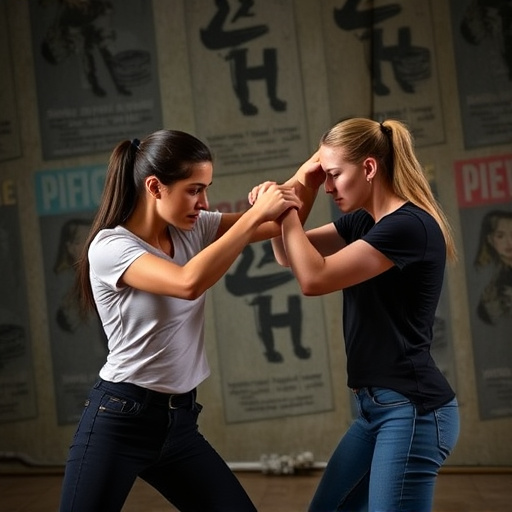Women's self-defense encompasses physical techniques (martial arts), verbal tactics (assertive communication), and mental preparation, tailored to individual comfort and lifestyle. Key strategies include situational awareness (reading body language, choosing safe routes) and understanding legal aspects like stand-your-ground laws and consent definitions. Regular self defense for women tips classes offer practical training in physical strikes, blocks, and escapes, building muscle memory for swift reactions. Mental preparedness turns fear into empowerment, enhancing confidence and resilience to navigate potentially dangerous situations, ultimately prioritizing personal safety.
“Empowering women with self-defense strategies is an essential step towards ensuring their safety and peace of mind. This comprehensive guide explores various facets of self-protection, from physical and verbal techniques to situational awareness and legal rights. We’ll navigate the importance of practical training and mental preparation, offering valuable tips for women to take charge of their security. Discover how these strategies can transform your daily life, giving you the confidence to face potential threats head-on.”
Understanding Your Options: Physical and Verbal Self-Defense Techniques
When it comes to self-defense, understanding your options is key. Women have a variety of strategies at their disposal, ranging from physical techniques to powerful verbal tactics. Physical self-defense for women involves learning basic martial arts moves, such as kicks, punches, and joint locks, which can be effective in deterring an attacker. These skills build confidence and enable you to react instinctively if needed.
Verbal self-defense is equally important. It includes assertive communication techniques like using firm language to set boundaries, making loud noises to draw attention, and delivering powerful statements that assert your autonomy. Practicing these verbal strategies can help de-escalate potentially dangerous situations, allowing you to maintain control and safety. Remember, every woman’s experience is unique, so it’s essential to choose self-defense tips and techniques that align with your comfort level and lifestyle.
Situational Awareness: Recognizing Potential Threats in Daily Life
Staying safe is a top priority, especially for women who may face unique challenges in everyday life. One of the most effective self-defense strategies begins with situational awareness—a key skill to recognize and avoid potential threats. By being mindful of your surroundings, you can spot suspicious activities or individuals long before they become dangerous.
Paying attention to your environment involves observing body language, noting unusual behavior, and being cognizant of busy areas versus quiet, isolated spots. For instance, when walking alone, choose well-lit paths with good foot traffic. These simple awareness tactics can empower women to make informed decisions, ensuring their safety during daily routines, according to self-defense for women tips experts.
Legal Aspects: Knowing Your Rights and Local Laws for Self-Defense
When considering self-defense strategies for women, understanding the legal aspects is crucial. Knowledge of your rights and local laws empowers you to act effectively in potentially dangerous situations. Each jurisdiction has specific rules regarding self-defense, including what constitutes reasonable force. Familiarize yourself with these laws to ensure your actions are legally justifiable.
One key tip among self defense for women tips is to stay informed about your state’s stand-your-ground laws and the rules around using force during an attack. Additionally, understanding the legal definitions of consent and assault can help you navigate potentially ambiguous situations. Proactive learning allows you to act confidently, knowing your rights, which is a vital aspect of personal safety for women.
Practical Training: Effective Self-Defense Classes and Practices for Women
Women’s self-defense classes offer practical training that goes beyond theory, equipping individuals with tangible skills to protect themselves in real-life situations. These classes often focus on developing physical strength, balance, and coordination while teaching effective strikes, blocks, and escapes. Instructors provide personalized guidance, ensuring each student understands the techniques’ mechanics and applications.
Practical training also involves simulated scenarios that replicate potential threats, allowing participants to practice responding calmly and confidently. By regularly engaging in such exercises, women can build muscle memory, enabling them to react swiftly and effectively when faced with an attack. This hands-on approach is a powerful tool for enhancing self-defense capabilities and instilling a sense of empowerment.
Mental Preparedness: Building Confidence and Resilience for Personal Safety
Mental preparedness is a powerful tool in any self-defense strategy, especially for women who often face unique challenges in ensuring their personal safety. Building confidence and resilience is key to staying calm and assertive when confronted with potentially dangerous situations. By cultivating a strong mental mindset, women can transform fear into empowerment, enabling them to make quick decisions and take decisive actions if needed.
Self-defense for women tips often emphasize the importance of awareness and assertiveness. This starts with recognizing potential threats and trusting one’s instincts. Regular practice of self-defense techniques, whether through martial arts or simple awareness exercises, can boost confidence levels significantly. Moreover, visualizing successful outcomes and maintaining a positive mindset can enhance resilience, allowing individuals to respond effectively in stressful situations, ensuring their personal safety becomes a priority.
